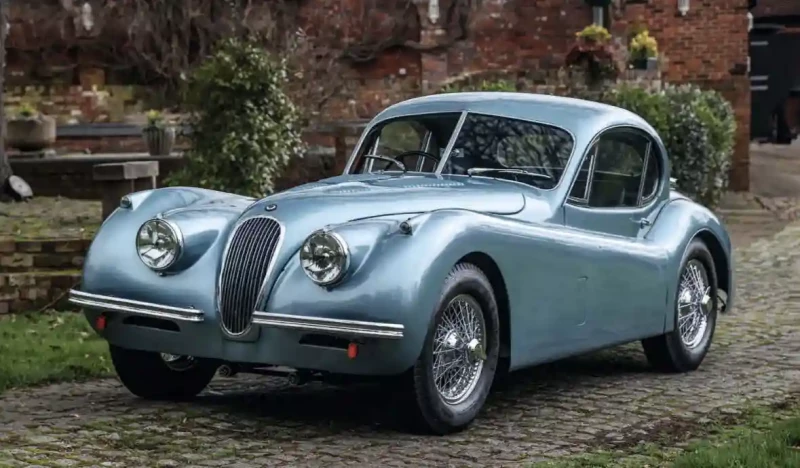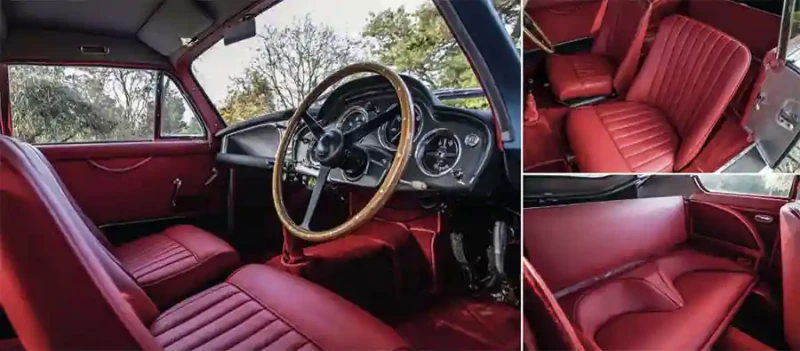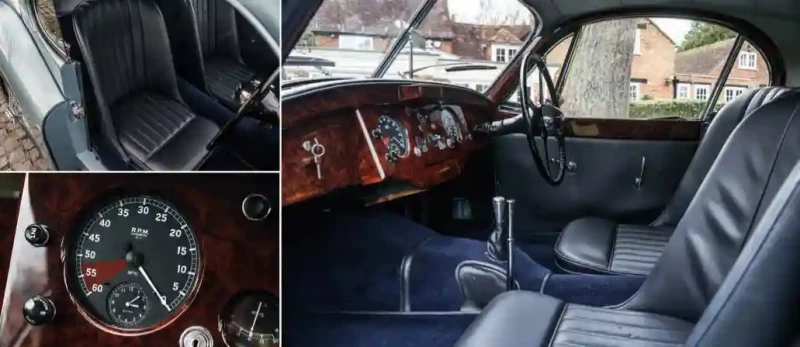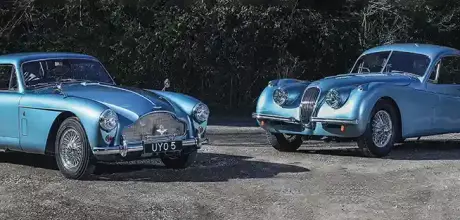1953 Jaguar XK120 FHC vs. 1957 Aston Martin DB MKIII
007 very nearly got an E-type for the Goldfinger film — but he also came close to a Jaguar in the novel upon which it was based. Which of these original Goldfinger cars makes for the best classic experience today?
WORDS: SAM SKELTON
PHOTOGRAPHY: PETER SEABROOK
GOLDFINGER REMATCH
SPORTING HEROES TWIN TEST JAGUAR XK120 FHC vs. ASTON MARTIN DB MKIII

We all know that James Bond drives an Aston Martin DB5 – let's face it, it remains just about the best piece of automotive product placement in history, and loaning a prototype DB5 to Eon Productions in 1963 for the film adaptation of Goldfinger was a very clever decision. A decision that must have sparked regret over the years at Brown’s Lane, given the reports that 007 had only gone to Newport Pagnell in the first place because Sir William Lyons had said no. Jaguar had refused to loan Cubby Broccoli an E-type for filming purposes, claiming it could already sell more E-types than it was able to build. While Jaguar has clawed back some of the opportunity for exposure in the last 20 years or so, it’s been peripheral when compared with Aston – Jaguars have always been driven by the bad guys or the supporting cast. But while the DB5 fitted in with Fleming's original novel, the fact is that even there it was only seemingly a twist of fate that meant Bond wasn’t sitting behind an XK engine.


Ian Fleming wasn’t exactly precise when it came to the cars used in the literary Goldfinger. Tilly Masterson’s Triumph TR3 was clear enough, as was the evil Auric’s Rolls-Royce Silver Ghost, replete with canary yellow bodywork and riveted armour plating made of solid white gold. But Bond’s own car was different. He was offered a choice of two cars, neither of which is made entirely clear by the form noted in print. He eschewed the Jaguar 3.4 from the motor pool for an Aston Martin DB3, complete with minor gadgets including a sonar tracker. But the DB3 didn’t exist – at least, not as a production model. And while it would be amusing to think of Bond tearing through Northern France and Switzerland in a DB3S Le Mans car, the truth is that Fleming probably meant the DB MkIII we have in these pages. And while there was a small saloon called a Jaguar 3.4; the retrospectively-named Mk1 precursor to bank robber favourite the Mk2, it’s more than possible that Fleming was referring to the 3.4 litre Jaguar XK sports cars which offered Aston Martin performance at a reduced price. And the last of the famed XK120s would have been only four years old at the time of Fleming’s book, so it’s likely that it was one of these, rather than a staid saloon, that had caught the author’s eye as a possible MI6 pool car for our hero. So if we return to the moment where our literary friend was standing in the MI6 car pool and picking a car, did 007 make the right decision in plumping for the Aston over the Jag? Which of our two 1950s sports cars would make the best choice for tailing an evil villain across half of Western Europe?

There’s only one way to find out, and that’s to pit them head to head. The Jaguar came first, and took the world by storm in 1948 in a way that few other cars short of the Citroen DS and Jaguar E-type have ever achieved. Here in austere post-war Britain was a long, low, swoopy sports car that could achieve 120mph with ease and which had an up-to-the-minute engine lurking beneath the silky shape.
Jaguar’s plan was to use the car as a halo model; to develop the engine in a low volume model before fitting it to the next generation of saloons. Initially launched as a roadster in 1948 and alloy-panelled until 1950, the XK120 range was expanded with a fixed head coupe for 1951, and a convertible roadster with winding windows and a folding roof for 1953. Successive iterations in the XK family would follow this three model formula, with a sporting roadster, comfortable coupe and convertible compromise available not only for the XK140, but for the final XK150 model too. Only the first 242 XK120s were actually capable of the full 120mph experience, courtesy of their aluminium panelling – subsequent cars would be weightier owing to the switch to steel panels.
While the XK120 was the first iteration of its illustrious line, the DB we have on test was the final model in its family before the launch of the all-new DB4. The MkIII – strictly the DB2/4 MkIII, according to its chassis plate – was the final fling for a series which had begun in 1948 with the DB1 roadster. The DB2 was to be a very different car to the DB1, which had originally launched as the 2-Litre Sports – it used a Lagonda straight-six that had been designed by W. O.
Bentley, fitted to a shortened version of the DB1 chassis and clothed in a lissom body designed by Frank Feeley. From 1953, it was replaced by the DB2/4 – while most believe the newer model to have been 2+2 only, it was in fact available with the two seat body as a rare option. By 1957, the DB2/4 MkII was looking a little staid, and it was time for a fresh face. Its successor lost the 2/4 portion of its name to become the DB MkIII. With a new grille designed by 17-year-old John Turner (which would set the tone for all future Aston Martins), the new car looked like a strong evolution – changes which would be bolstered by a new instrument panel, and after the first 100 front disc brakes and a Laycock-de-Normanville overdrive unit would become standard. Rear lights from the Humber Hawk would be fitted after the first few cars, too.
As standard, the DBA engine was fitted, offering 162bhp. However, an optional high output model was offered with the 195bhp DBB unit, fitted with triple Webers, high compression pistons and a revised exhaust. Just ten of these were built, alongside 47 DBD-engined cars with triple SUs and 180bhp. One car was fitted with a DBC competition engine, close in specification to those used in the DB3S, while a second car was subsequently uprated to DBC specification. But was the Aston’s fresh face and uprated engine enough of an incentive for 007 to pick one over a Jaguar?
That’s what we’re here to find out, with examples of both; a 1957 DB MkIII and a 1953 XK120 fixed-head coupe courtesy of Runnymede Motors. Cosmetically, it’s a hard one to call. The XK120 has always been a stunning shape for its era and this car, finished in the non-original shade of Opalescent Silver Blue, is no exception. As the sun glints from the curve above the rear arch, as it falls into the bootline, you see something that owes just as much to one man’s eye as it does to aerodynamics. And while it’s perhaps a shade heavy from the rear. position by modern tastes even without the wheel spats fitted to cars with steel wheels, that’s compensated for by the sheer beauty of the front. aspect. The XK120 is a timeless piece of design, and its litany of fans will ensure it remains popular. This example is fresh from a bare metal rebuild, and is arguably as close to a brand new XK120 as you will find anywhere in the world.
The Aston Martin is rarer, and to a degree overshadowed by the DB4 which followed it. A production run of just two years and 551 examples means that alongside over 12,000 XK120s, the Aston is certainly the rarer sight. But finished in original Elusive Blue, it’s a more handsome car even if it’s less immediately striking than the Jaguar. The fresh nose suits the shape better than the outgoing DB2/4 front did, while there’s almost something of the later DB6 to the windowline. It’s less flamboyant and continental than the Touring-designed Astons, but British and tasteful despite that. The interior of our test car; Crimson Red Vaumol leather, only bolsters that effect. While the Jaguar has been the subject of a full restoration, the Aston’s undergone more of an evolution over time; twenty years of continual maintenance at a cost of Åí80,000 mean that under the recent paint and the retrim sits a very healthy example. Overall, we’d give the nod to the Aston on looks – it’s less contentious and more traditional than the Jaguar, as well as hiding extra practicality behind the style.
Settle down inside the Jaguar XK120, and it’s a powerful reminder of just how much people have grown over time. Since the early 1950s, the average British male has grown by over two inches in height, gained a stone in weight, and grown two shoe sizes, and for taller and more corpulent drivers the XK120 simply feels tight. The roof is only about an inch above your head and there’s little in the way of shoulder room. While it might have offered reasonable space when new, the same can’t be said today – certainly not for drivers north of six feet tall and fifteen stone.
The interior is very well-appointed however, with a walnut dashboard in perfect order, seats freshly trimmed in Connolly Vaumol leather and beautiful carpets. It looks brand new – not a surprise when you find that this example has covered fewer than 100 miles since a bare metal restoration.
You sit perhaps a shade closer to the wheel than you might like – a near vertical wheel, with the boss pointing straight to your heart. Dials are central, with an anti-clockwise tachometer on the left and a cluster of auxiliary gauges along the centreline of the car. The sound of the XK engine is one well-known to classic enthusiasts; having powered many of the marque’s models from the late 1940s right into the 1990s – and while in this iteration it has just 160bhp to play with it doesn’t feel like it’s lacking grunt. It would be unfair of us to comment on the gearshift quality, as this particular car has been fitted with a Tremec five-speed conversion in place of the original Moss unit. We’ve used Moss boxes before, though, and they’re perfectly enjoyable despite the lack of synchromesh on first and no desire to be hurried. The ride is firm by period standards, but perfectly adequate when considered alongside modern cars – and it’s well-damped, too.
Nothing about the way this car drives would dissuade you from a trip into Europe, with the possible exception of the compromised luggage space in that sloping tail. It seems surprising from a car which was once lauded as the fastest production car in the world, but it’s perfectly happy to sit in a high gear and burble along on a wave of torque for hours at a time. It might not be as refined nor as smooth as the Aston Martin, but there’s certainly nothing wrong with the manners of this car to say the design is now 75 years old.
The Aston Martin, however, instantly feels like a more accomplished grand tourer than the Jaguar. Space inside is greatly improved, with plenty of headroom and shoulder room in the front for two large adults, and even a rear seat which would be adequate for occasional use. The hatchback, an innovative fitment for the time, especially on a sports car, offers far more usable luggage space than the Jaguar, too. And if you don’t need the rear seats, you can extend the load bay by folding down the rear seat backlike scores of more modern hatchback designs. The dashboard may not feel as plush as that of the Jaguar with metal and leather taking the place of walnut, but it does feel more personal; the gauges are clustered ahead of the driver, and there’s a useful cubby ahead of the passenger. It feels like a betterconsidered machine for long distance touring even before you turn the key.
But where the Aston really excels is on the road. It’s far more softly sprung than the Jaguar, riding as well as a saloon car with excellent damping characteristics. The steering is both nicely geared and accurate, helped in the case of this car by increased negative camber to the front wheels. Many examples can be heavy, but set up well and on good tyres there’s nothing unpleasant about the way these cars steer. This one pulls better than a standard example, too, courtesy of upgrades performed during an engine rebuild in 2003. The gearbox is precise, with overdrive operating on top to ensure cruising speeds worthy of a cross-Europe blast in chase of Mr Goldfinger’s Silver Ghost. Driven against an earlier DB2/4, you really get an idea of the sort of benefit that can come from a combination of racing experience and gradual evolution; this car feels far more polished than its predecessors ever did. Longlegged, yet quick, sporting yet docile, when viewed against the period alternatives this is a hard car to beat.
CONCLUSION
If I had been a late-1950s government agent in need of a sporting coupe, this choice would have been difficult, and it’s easy to see why the optional extras fitted to the Aston were the things which ultimately swayed 007 in favour of the DB MkIII – the Homer apparatus, the reinforced bumpers and the up to date paperwork would all be necessary as the plot developed, even if the concealed cubbies and the switches to alter the look of his lights at night weren’t used. If we strip away any emotional value and we look at the benefits each car could offer for his mission, the Aston is the obvious choice when the firm’s picking up the bill.
The Jaguar is equally good, though it would certainly have appealed to a different type of customer when new given that it was a far less expensive car when it was new. Remember that the Jaguar was still three times the average manual worker’s salary, even if it was half the price of the Aston Martin – neither was a cheap car, but one was considerably more attainable than the other. While the Jaguar might just about have been an achievable dream, even a secondhand Aston would have been well beyond the means of the working and middle classes. Today, the proportional difference hasn’t changed, with a good Aston like the car we have on test valued at the equivalent of two Jaguars plus change.
And that differential is why, despite offering a more complete package, the Aston Martin simply cannot win this test in 2023. Yes, it’s more roomy, more comfortable, and softer – but when the price difference could buy you a property the Jaguar makes infinitely more sense in 21st century Britain. And it’s not like the compromise really feels like a compromise either – those who choose the Jaguar are still in one of Britain’s best-regarded classic sorts cars, and a model which in its 75th anniversary year attracted far more attention from far more fans than the Aston Martin 2 Litre Sports of similar vintage. Jaguar might have been overlooked by James Bond on two separate occasions on page and on screen, but in the real world, it’s the Aston that plays second fiddle.
THANKS TO: Runnymede Motor Company
DATA TECH
TECHNICAL DATA SPECIFICATION 1953 JaguarXK120 FHC
- ENGINE: 3.442cc I6
- MAX POWER: 160bhp
- MAX TORQUE: 195lb ft
- ACCELERATION 0-60MPH: 10.0secs
- TOP SPEED: 121mph
- TRANSMISSION: 4-spd man
- ECONOMY: 17mpg
- PRICE NEW: $1616, 2s, 6d (1953)
- VALUE NOW: $50k-120k
TECHNICAL DATA SPECIFICATION 1957 Aston Martin DB MKIII
- ENGINE: 2,922cc I6
- MAX POWER: 162bhp
- MAX TORQUE: 180lb ft
- ACCELERATION 0-60MPH: 9.3secs
- TOP SPEED: 120mph
- ECONOMY: 16mpg
- TRANSMISSION: 4-spd man
- PRICE NEW: $3076, 7s 0d (1957)
- VALUE NOW: $100k-285k
“Borpost, et, volliciet accab inis ad maio iumquia dolesedi odi sus mos simillumque nonse nis eum est eratem estiat ius”


